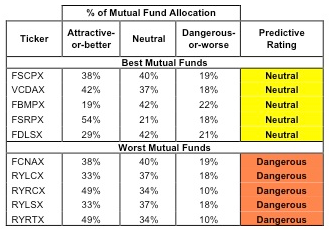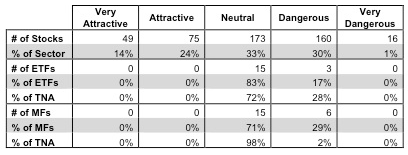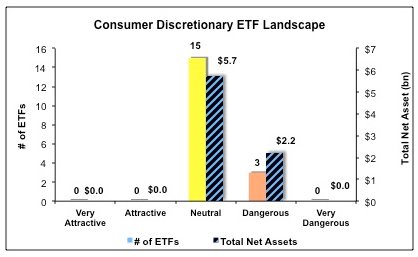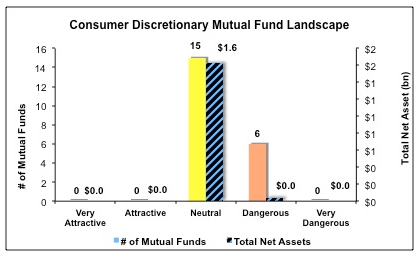The Consumer Discretionary sector ranks seventh out of the ten sectors as detailed in my sector roadmap. It gets my Neutral rating, which is based on aggregation of ratings of 18 ETFs and 21 mutual funds in the Consumer Discretionary sector as of July 12, 2012.
Figure 1 ranks from best to worst the nine Consumer Discretionary ETFs that meet our liquidity standards and Figure 2 shows the five best and worst-rated Consumer Discretionary mutual funds. Not all Consumer Discretionary sector ETFs and mutual funds are created the same. The number of holdings varies widely (from 25 to 373), which creates drastically different investment implications and ratings. The best ETFs and mutual funds allocate more value to Attractive-or-better-rated stocks than the worst ETFs and mutual funds, which allocate too much value to Neutral-or-worse-rated stocks.
To identify the best and avoid the worst ETFs and mutual funds within the Consumer Discretionary sector, investors need a predictive rating based on (1) stocks ratings of the holdings and (2) the all-in expenses of each ETF and mutual fund. Investors need not rely on backward-looking ratings.
Investors should not buy any Consumer Discretionary ETFs or mutual funds because none get an Attractive-or-better rating. If you must have exposure to this sector, you should buy a basket of Attractive-or-better rated stocks and avoid paying undeserved fund fees. Active management has a long history of not paying off.
Figure 1: ETFs with the Best & Worst Ratings – Top 5 (where available)

* Best ETFs exclude ETFs with TNA’s less than 100 million for inadequate liquidity.
Sources: New Constructs, LLC and company filings
4 ETFs are excluded from Figure 1 because their total net assets (TNA) are below $100 million and do not meet our liquidity standards.
Figure 2: Mutual Funds with the Best & Worst Ratings – Top 5
* Best mutual funds exclude funds with TNA’s less than 100 million for inadequate liquidity.
Sources: New Constructs, LLC and company filings
4 mutual funds are excluded from Figure 2 because their total net assets (TNA) are below $100 million and do not meet our liquidity standards.
Consumer Discretionary Select Sector SPDR (XLY) is my top-rated Consumer Discretionary ETF and Fidelity Select Portfolios: Consumer Discretionary Portfolio (FSCPX) is my top-rated Consumer Discretionary mutual fund. Both earn my Neutral rating.
iShares Dow Jones U.S. Home Construction Index Fund (ITB) is my worst-rated Consumer Discretionary ETF and Rydex Series Funds: Retailing Fund (RYRTX) is my worst-rated Consumer Discretionary mutual fund. Both earn my Dangerous rating.
Figure 3 shows that 124 out of the 473 stocks (38% of the total net assets) held by Consumer Discretionary ETFs and mutual funds get an Attractive-or-better rating. However, no Consumer Discretionary ETFs or Mutual Funds get an Attractive-or-better rating.
The takeaway: Consumer Discretionary sector mutual fund managers and ETFs are picking the wrong stocks in this sector. Their fees are undeserved, no matter how low.
Figure 3: Consumer Discretionary Sector Landscape For ETFs, Mutual Funds & Stocks 
Sources: New Constructs, LLC and company filings
As detailed in “Cheap Funds Dupe Investors”, the fund industry offers many cheap funds but very few funds with high-quality stocks, or with what I call good portfolio management.
Investors need to tread carefully when considering Consumer Discretionary ETFs and mutual funds, because all of them are rated either Neutral or Dangerous. I recommend investors focus instead on the 124 individual stocks that are rated Very Attractive or Attractive.
Autozone (AZO) is one of my favorite stocks held by Consumer Discretionary ETFs and mutual funds and earns my Most Attractive rating. Autozone has grown Revenue and NOPAT every year since. More impressive is AZO’s ability to become more profitable and efficient as it grows. Over the last 14 years, AZO has boosted its NOPBT margin (Net Operating Profits before Taxes) from 12% in 1998 to 19.6% in 2011. Simultaneously, AZO has improved its capital efficiency or asset turnover. Their ROIC has steadily climbed from 10.9% in 1998 to 25.0% in 2011, placing them in the 85th percentile for highest ROIC among Consumer Discretionary companies.
Growth in operating profits while simultaneously boosting capital efficiency is a recipe for rapid value creation and indicates exceptional capital stewardship. It would be no great feat to increase operating profits by $1 if it required $100 of incremental investment (a meager 1% return on invested capital). It is extraordinarily difficult, however, to grow consistently for over a decade and earn even higher returns on new investments. Autozone has made it look easy.
AZO is a great company, but its undervalued stock price makes it a great stock as well. Today’s market price of $382.45 assumed AZO will never grow its profits beyond 2011 levels.. That is a low expectation for a company that is a value-creating machine.
MGM Resorts International (MGM) is one of my least favorite stocks held by Consumer Discretionary ETFs and mutual funds and earns my Very Dangerous rating. Like Autozone, MGM has grown revenue substantially over the last 14 years. Unlike Autozone, however, MGM’s growth has been accompanied by a steady decline in profitability. In 1998, MGM was earning an unimpressive 4.5% ROIC. That number has eroded to a big-time-value destroying 1.8% in 2011. MGM’s invested capital has ballooned by 1830% with investments that have generated consistently lower returns. MGM is a great example of a company where growth only accelerates value destruction. Furthermore, in order to justify its current stock price, MGM would need to grow NOPAT 15% compounded annually for the next 10 years. It is hard to imagine where that profitable growth is going to come from when the company’s investments in the past have consistently earned low returns. Today’s price of $9.75 translates to very high expectations for this Very Dangerous-rated stock.
373 stocks of the 3000+ I cover are classified as Consumer Discretionary stocks, but due to style drift, Consumer Discretionary ETFs and mutual funds hold 473 stocks.
Figures 4 and 5 show the rating landscape of all Consumer Discretionary ETFs and mutual funds.
Figure 4: Separating the Best ETFs From the Worst ETFs 
Sources: New Constructs, LLC and company filings
Figure 5: Separating the Best Mutual Funds From the Worst Mutual Funds 
Sources: New Constructs, LLC and company filings
Disclosure: I receive no compensation to write about any specific stock, sector or theme.
- English (UK)
- English (India)
- English (Canada)
- English (Australia)
- English (South Africa)
- English (Philippines)
- English (Nigeria)
- Deutsch
- Español (España)
- Español (México)
- Français
- Italiano
- Nederlands
- Português (Portugal)
- Polski
- Português (Brasil)
- Русский
- Türkçe
- العربية
- Ελληνικά
- Svenska
- Suomi
- עברית
- 日本語
- 한국어
- 简体中文
- 繁體中文
- Bahasa Indonesia
- Bahasa Melayu
- ไทย
- Tiếng Việt
- हिंदी
Best And Worst ETFs (And Mutual Funds): Consumer Discretionary Sector
Published 07/15/2012, 04:43 AM
Updated 07/09/2023, 06:31 AM
Best And Worst ETFs (And Mutual Funds): Consumer Discretionary Sector
3rd party Ad. Not an offer or recommendation by Investing.com. See disclosure here or
remove ads
.
Latest comments
Install Our App
Risk Disclosure: Trading in financial instruments and/or cryptocurrencies involves high risks including the risk of losing some, or all, of your investment amount, and may not be suitable for all investors. Prices of cryptocurrencies are extremely volatile and may be affected by external factors such as financial, regulatory or political events. Trading on margin increases the financial risks.
Before deciding to trade in financial instrument or cryptocurrencies you should be fully informed of the risks and costs associated with trading the financial markets, carefully consider your investment objectives, level of experience, and risk appetite, and seek professional advice where needed.
Fusion Media would like to remind you that the data contained in this website is not necessarily real-time nor accurate. The data and prices on the website are not necessarily provided by any market or exchange, but may be provided by market makers, and so prices may not be accurate and may differ from the actual price at any given market, meaning prices are indicative and not appropriate for trading purposes. Fusion Media and any provider of the data contained in this website will not accept liability for any loss or damage as a result of your trading, or your reliance on the information contained within this website.
It is prohibited to use, store, reproduce, display, modify, transmit or distribute the data contained in this website without the explicit prior written permission of Fusion Media and/or the data provider. All intellectual property rights are reserved by the providers and/or the exchange providing the data contained in this website.
Fusion Media may be compensated by the advertisers that appear on the website, based on your interaction with the advertisements or advertisers.
Before deciding to trade in financial instrument or cryptocurrencies you should be fully informed of the risks and costs associated with trading the financial markets, carefully consider your investment objectives, level of experience, and risk appetite, and seek professional advice where needed.
Fusion Media would like to remind you that the data contained in this website is not necessarily real-time nor accurate. The data and prices on the website are not necessarily provided by any market or exchange, but may be provided by market makers, and so prices may not be accurate and may differ from the actual price at any given market, meaning prices are indicative and not appropriate for trading purposes. Fusion Media and any provider of the data contained in this website will not accept liability for any loss or damage as a result of your trading, or your reliance on the information contained within this website.
It is prohibited to use, store, reproduce, display, modify, transmit or distribute the data contained in this website without the explicit prior written permission of Fusion Media and/or the data provider. All intellectual property rights are reserved by the providers and/or the exchange providing the data contained in this website.
Fusion Media may be compensated by the advertisers that appear on the website, based on your interaction with the advertisements or advertisers.
© 2007-2024 - Fusion Media Limited. All Rights Reserved.
